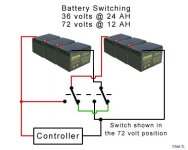There's been quite a bit of discussion and at least one thread here dedicated to this topic of a series/parallel switch. I searched but couldn't find it.
In short, switching for example between 72volts 10ah and 36 volts 20 ah won't buy you much if any increased range because either way it's still a 720 watt-hour battery pack and on any given system it takes X watts to travel Y speed. For example, going 20mph with 72volts will take roughly 400 watts, which means 400W/72volts = 5.5 amps. Going 20mph with 36 volts will take 400W/36volts = 11 amps.
There is a small efficiency gain from the controller input voltage more closely matching the controller average output voltage, but in practice the gain is too small to make a parallel/series switch worthwhile for most people.
One good reason to implement such a switch is if you want finer throttle control at low speeds. At 72 volts, for example, half throttle might accelerate you to 20mph, whereas with 36 volts, full throttle will accelerate you to 20mph. Hence, low speed throttle control is better. But this hasn't been an issue for me or most other people with 72V+ systems.
Another reason may be if you're "heavy handed" on the throttle, and want to constrain yourself to a lower speed limit because holding only partial-throttle becomes too tiring, or it's too tempting to flick full-throttle.
I have a 10S15P lithium pack on my back rack, wired in series to a 10S15P lithium pack on my midframe. If I wanted I could quickly disconnect and reconnect the wires between, or add a little relay box, to make the entire pack 10S30P instead of 20S15P. Just not enough reason for me to do so, though.


